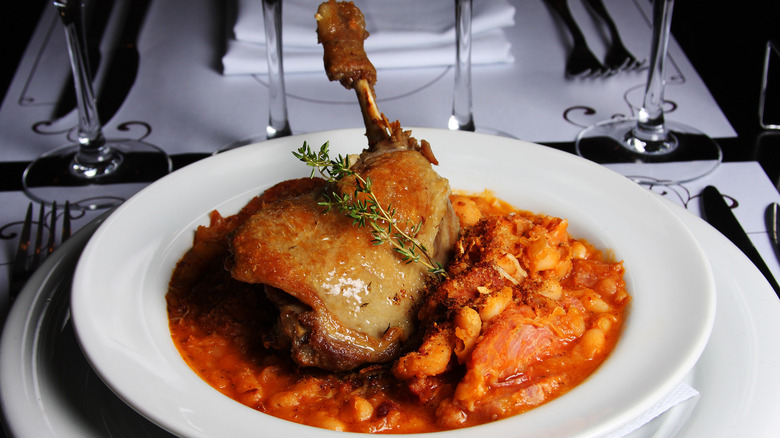The Rustic French Origins Of Cassoulet
Cassoulet, a hearty and comforting dish hailing from the southwest region of France, has a rich history with plenty of regional variation (via Britannica). It is a dish that has stood the test of time and continues to be a beloved staple in French cuisine.
The origin of cassoulet can be traced back to the medieval town of Castelnaudary in the Languedoc region of France. During this time, the town Castelnaudary was under siege by the English army, and the residents were running out of food (via D'Artagnan). In a desperate attempt to feed the hungry townspeople, the locals gathered whatever ingredients they had on hand, including beans, pork, and duck, and slow-cooked them together in a large pot. The resulting dish was a hearty and satisfying meal that not only fed the townspeople, but also lifted their spirits.
From this humble beginning, cassoulet slowly made its way around the Languedoc region, becoming a beloved dish in the towns and villages of the area. Each community put their own spin on the dish, using different types of meats and beans, and adding their own unique seasonings and spices (via Grapes and Grain).
As cassoulet gained popularity, it began to spread beyond Languedoc, making its way to the nearby regions of Toulouse and Carcassonne. It was in these two towns that the dish truly came into its own, with each town claiming to have the "original" and "authentic" recipe.
Cassoulet's popularity spread further
Today, the Castelnaudary rendition has ham, pork, tomatoes, and white beans. In Toulouse, cassoulet is made with a combination of white beans, duck or goose confit, and a regional sausage while in Carcassonne, the dish is made with a combination of white beans, mutton, and partridge (via Britannica). Both alternate versions are delicious, and the debate over which is the "real" cassoulet continues to this day.
As cassoulet continued to spread throughout France, it also made its way across the Atlantic to the United States where it quickly gained popularity among French expats and food enthusiasts (via Bon Appétit). Today, cassoulet can be found on the menus of many French restaurants in the United States, and it remains a beloved dish in the French culinary canon.
More recently, cassoulet has also been embraced by the Slow Food movement, which promotes the traditional ways of food and the use of local, sustainable ingredients. This has led to a renewed interest in the dish, and many chefs and home cooks are experimenting with different ingredients and techniques to put their own spin on the recipe.
Despite the many variations and interpretations of cassoulet, one thing remains constant: Its ability to bring people together. Whether enjoyed in a cozy bistro in Toulouse or a home kitchen in the United States, cassoulet has the power to create a sense of community and comfort. With its rustic history and comforting flavors, it's no wonder that this dish has stood the test of time and continues to be beloved in French cuisine, so be sure to stock your pantry with these French staples.

